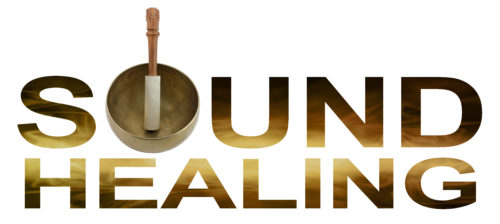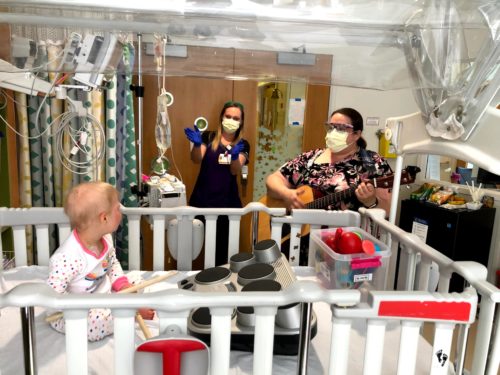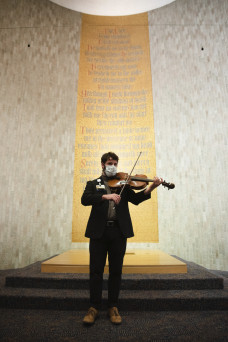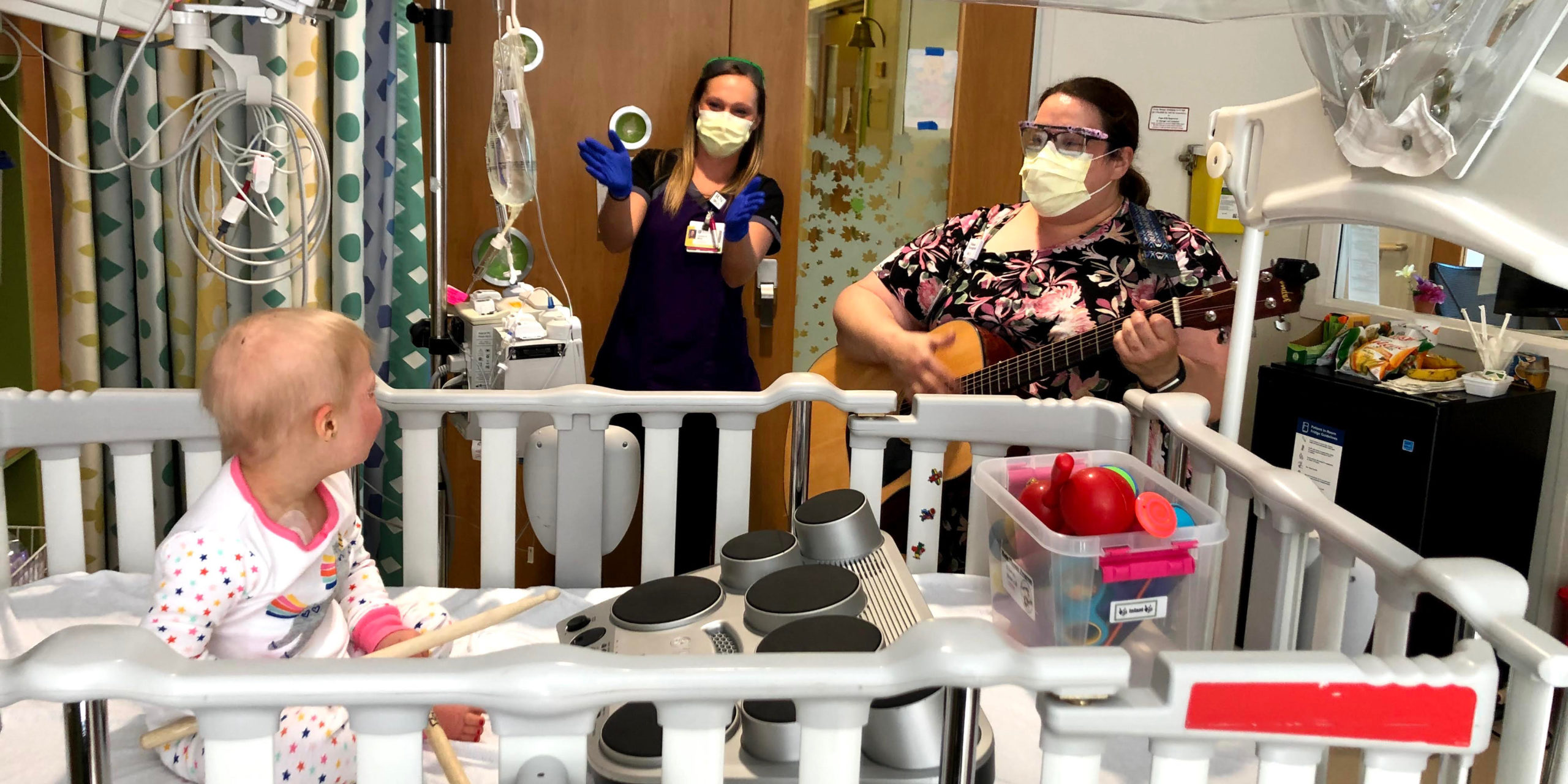By Terri Medina
Music heals. Music evokes memories and feelings. Music allows us to remember a specific moment in time. A beat, a note, a sound. Simply strummed or hummed, arranged and performed, music resounds deeply inside us and opens up our hearts and minds.

URMC has been using music as a therapeutic tool since 1997, when OJ Sahler, MD, behavioral pediatric oncologist at Golisano Children’s Hospital, collaborated with the music therapy program at Nazareth College with the goal of bringing music to patients of all ages. Since then, Strong, in conjunction with Eastman Performing Arts Medicine (EPAM) has helped thousands of patients heal, recover, and find peace.
“EPAM has helped this program grow, and by bringing the arts to the medical center, has highlighted the vital role that music therapy plays in the healing process,” said Jackie Beckerman, chief patient experience officer & senior director of the ICARE Commitment.
The Team Behind the Program
“Music therapy has been proven to reduce stress, pain and nausea, as well as improve body movement and emotional duress,” said Rosemary Obi, MS, senior music therapist, who has been a part of the music therapy program since 2000. “Evidence shows that music positively impacts the body and brain.”
Patients engaging with music as a way to create a more comfortable environment has proven to help in their recovery. Using familiar songs, beats and even improvisation Obi and her team, including Elaine Kong, who primarily works in the Neonatal and Pediatric Intensive Care Units, Madeline Mitchell, who works in the Pediatric Cardiac Care Center and general pediatric inpatient units, and Molly Pow, who works with the adult patient population in the 5-1200 rehabilitation unit and adult ICUs, make useful connections with patients based on their specific needs.
Until Obi arrived, music therapy was limited to those receiving bone marrow transplants participating in a pilot study. But once word spread about its efficacy, it spread to other areas within the hospital.
Obi, a licensed creative arts therapist and board-certified music therapist, said she often heard from parents who inquired about the use of music therapy with their children. “Medical staff became increasingly interested when they saw how effective it was with the younger population of patients,” she said.
The program received an NIH grant in 2001 which allowed Obi to continue bone marrow transplant research and expand services to the pediatric population. Research on the benefits of music therapy also began to provide evidence-based improvement for patients who had music therapy incorporated into their treatment plans.
“We use music to help with social, emotional, cognitive and physical needs,” she said. “Our goal is not to make our patients rock stars. We talk about what kind of music they like, we explore instruments and sounds and give patients some control in a safe place, where they often don’t have much control.”
A Fruitful Collaboration
Gaelen McCormick, director of EPAM, has a personal connection to music therapy. McCormick was a member of the Rochester Philharmonic Orchestra, but began a career in arts administration and nonprofit leadership after losing her hearing in 2017.
“I personally understand how music therapy relates to quality of life, and is helpful to both patients and their families,” she said. “Music connects us back to who we are as humans. There is an innate level of communicating through music.”
Sessions sometimes look different for adults and children, whether it be for physical or emotional rehabilitation or creating a dialogue with patients about their goals. Therapy is adjusted to meet individual goals in a developmentally appropriate way. Some music therapy outcomes have included patients tripling their walking distance within a month, decreased need or want for pain medication, and better processing of one’s medical journey.

Rosemary Obi provides music therapy to the youngest patients.
Music therapy is often used to co-treat with another therapeutic service such as speech, physical, and occupational therapy. A music therapist might compose a song with lyrics that include step-by-step directions for how to do a task, or move properly. Or they may match an exercise with a regular rhythmic beat.
Obi’s team often incorporate patient preferences in therapy, using music they like to help them move, or in some cases, find their voice. A lot of the individual sessions can be emotional, and staff will work with patients on mantras, breathing or even recording their own voices or musical sounds.
The Beat Goes On
A parent, whose daughter was admitted and died while in the Pediatric Cardiac Care Center in 2016, shared their music therapy experience.
“When Elaine first came to my daughter’s room with a guitar on her back and little toy instruments in tow, I knew for the next half hour we’d be celebrating my daughter’s life,” said the parent.
When the patient was strong enough, she could hold her own instruments and chose her own songs. Some days, Kong was able to slow the patient’s heart rate down, stabilize her blood pressure, and even help her go to sleep.
“It was through music therapy that my daughter and I were able to simply be mother and child,” said the parent.
As a keepsake, Kong also provided a recording of the child’s heartbeat and breathing playing over the top of a special song.
“When I listen to the recording, I hear my daughter, and I know she’s still singing.”
 Arts Grant Secures Chapel Upgrades
Arts Grant Secures Chapel Upgrades
Eastman Performing Arts Medicine (EPAM) earned a National Endowment for the Arts grant to support updating the URMC Interfaith Chapel inside Strong Memorial Hospital with better audio and video capabilities.
For the first time, cameras and microphones tied into the hospital television service will allow for a variety of arts programming for patients to access from their rooms.
“The beautiful and historic chapel will be a place for music, dance, storytelling and spiritual services, said Gaelen McCormick, director of EPAM. “Livestreaming the arts from our chapel to our hospital community of patients, families and staff will make a positive impact on their health and well-being.”
In addition to music and other arts performances, live religious services will be offered again in the chapel.
